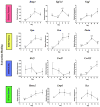Gene expression dynamics during bone healing and osseointegration
- PMID: 21142982
- PMCID: PMC3399909
- DOI: 10.1902/jop.2010.100577
Gene expression dynamics during bone healing and osseointegration
Abstract
Background: Understanding the molecular features of bone repair and osseointegration may aid in the development of therapeutics to improve implant outcomes. The purpose of this investigation is to determine the gene expression dynamics during alveolar bone repair and implant osseointegration.
Methods: An implant osseointegration preclinical animal model was used whereby maxillary defects were created at the time of oral implant placement, while a tooth extraction socket healing model was established on the contralateral side of each animal. The surrounding tissues in the zone of the healing defects were harvested during regeneration for temporal evaluation using histology, immunohistochemistry, laser capture microdissection, and quantitative reverse transcription-polymerase chain reaction for the identification of a panel of 17 putative genes associated with wound repair.
Results: In both models, three distinct expression patterns were displayed: 1) genes that are slowly increased during the healing process, such as bone morphogenetic protein 4, runt-related transcription factor 2, and osteocalcin; 2) genes that are upregulated at the early stage of healing and then downregulated at later stages, such as interleukin and chemokine (C-X-C motif) ligands 2 and 5; and 3) genes that are constitutively expressed over time, such as scleraxis. Although some similarities between osseointegration and tooth extraction socket were seen, distinct features developed and triggered a characteristic coordinated expression and orchestration of transcription factors, growth factors, extracellular matrix molecules, and chemokines.
Conclusions: Characterization of these events contributes to a better understanding of cooperative molecular dynamics in alveolar bone healing, and highlights potential pathways that could be further explored for the enhancement of osseous regenerative strategies.
Figures





References
-
- Panetta NJ, Gupta DM, Longaker MT. Bone regeneration and repair. Curr Stem Cell Res Ther. 2010;5:122–128. - PubMed
-
- Gersbach CA, Phillips JE, García AJ. Genetic engineering for skeletal regenerative medicine. Annu Rev Biomed Eng. 2007;9:87–119. - PubMed
-
- Kimelman N, Pelled G, Helm GA, Huard J, Schwarz EM, Gazit D. Review: Gene- and stem cell-based therapeutics for bone regeneration and repair. Tissue Eng. 2007;13:1135–1150. - PubMed
-
- Lee J, Stavropoulos A, Susin C, Wikesjö UM. Periodontal regeneration: Focus on growth and differentiation factors. Dent Clin North Am. 2010;54:93–111. - PubMed
Publication types
MeSH terms
Substances
Grants and funding
LinkOut - more resources
Full Text Sources
Medical
Molecular Biology Databases

